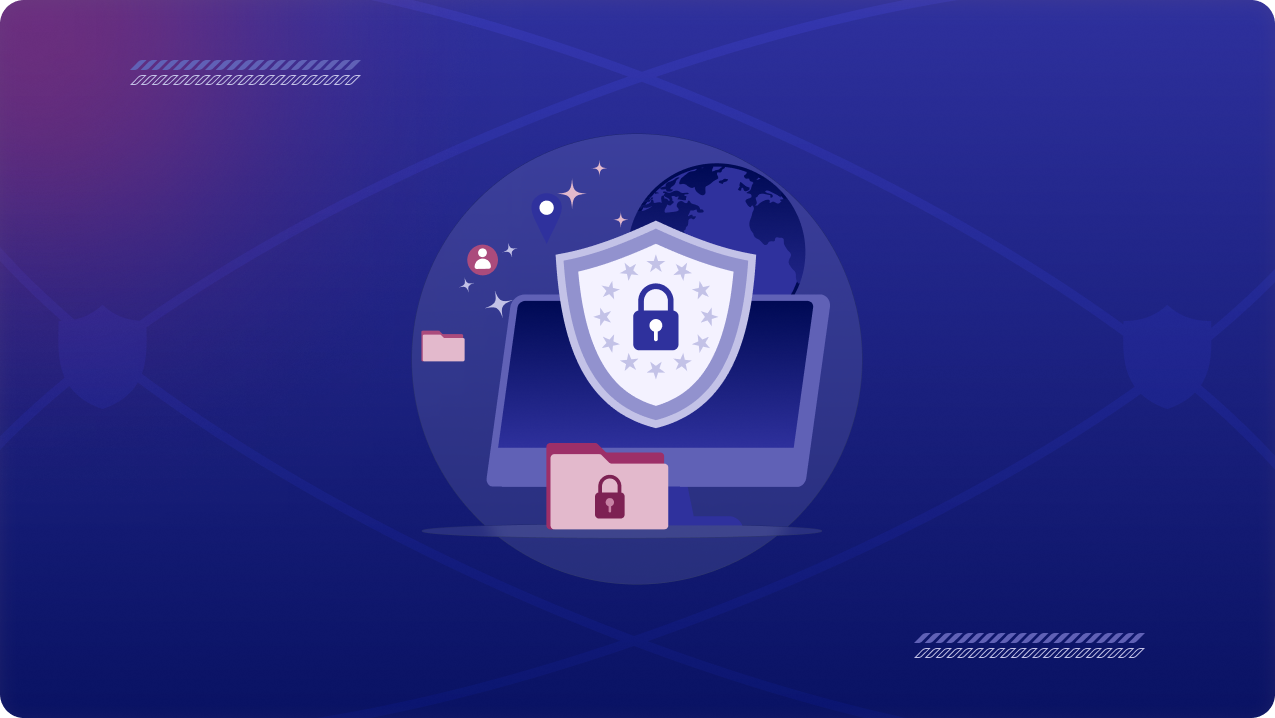Table of Contents
With the global average cost of a data breach reaching $4.88 million in 2024, data encryption, or safeguarding data as it moves across networks, has become a critical priority for businesses of all sizes. Cyberattacks targeting data in transit – whether emails, financial transactions, or sensitive business communications – are not only on the rise but are getting increasingly sophisticated.
Data encryption, the process of encoding data so only authorized parties can decode it, is the most effective way to secure data in transit. Without proper encryption measures, cybercriminals can intercept, modify, or steal sensitive business information through various attack vectors such as man-in-the-middle attacks and packet sniffing, which may lead to devastating financial and reputational losses.
This comprehensive guide discusses the strategic roadmap to encrypt data in transit, offering actionable insights to mitigate risks while maintaining operational efficiency.
Here’s how you to get started.
Step 1: Assess Your Current Data Transmission Security
Before implementing data encryption standards and protocols, it is crucial for businesses to evaluate their existing infrastructure to identify vulnerabilities through a comprehensive security assessment framework. Here’s how to begin:
1. Map Data Flows
Document how data moves across your network – including endpoints, devices, servers, and third-party systems. You can create detailed network diagrams that include:
- Layer 2 and Layer 3 network topology
- Application communication paths
- Data classification levels
- Encryption points and protocols
- Trust boundaries and security zones
2. Identify Sensitive Data
Determine which data types are most critical to protect, such as financial records, customer information, or intellectual property. Consider:
- Data classification frameworks, such as Public, Internal, Confidential, and Restricted
- Regulatory requirements, like the General Data Protection Regulation (GDPR), Health Insurance Portability and Accountability Act (HIPAA), California Consumer Privacy Act (CCPA), and Payment Card Industry Data Security Standard (PCI DSS).
- Business impact analysis results
- Data retention and disposal requirements
3. Audit Existing Encryption Protocols
Check if current protocols like Hypertext Transfer Protocol Secure (HTTPS ), Secure File Transfer Protocol (SFTP), or Transport Layer Security (TLS) are implemented correctly and meet industry standards:
- Verify TLS version and cipher suite configurations
- Review certificate management practices
- Assess key rotation policies
- Evaluate protocol-specific security controls
4. Evaluate Third-Party Security
Ensure that vendors and partners handling your data also adhere to strong encryption practices:
- Review vendor security assessments
- Verify compliance certifications
- Assess data handling agreements
- Monitor third-party access controls
Step 2: Implement Data Encryption Protocols
Modern data encryption standards are the backbone of securing data in transit. Adopt these tried-and-tested protocols to ensure your organization’s communications remain protected.
1. TLS (Transport Layer Security)
TLS is essential for encrypting web traffic. Implement TLS 1.3 with specific considerations:
- Configure perfect forward secrecy (PFS)
- Enable session resumption for performance
- Implement Online Certificate Status Protocol (OCSP) stapling
- Use strong data encryption standards, such as Advanced Encryption Standard or AES-256
- Regular security assessments using tools like SSL Labs
2. HTTPS (HyperText Transfer Protocol Secure)
HTTPS combines HTTP with TLS, encrypting data sent between browsers and websites. Ensure all internal and external-facing web applications are HTTPS-compliant.
- Enable HTTP Strict Transport Security (HSTS)
- Implement Content Security Policy (CSP )
- Configure proper certificate chains
- Use automated certificate management such as Let’s Encrypt
- Regular security headers assessment
3. VPNs (Virtual Private Networks)
VPNs encrypt the connection between devices and the company networks, ensuring that all data traffic remains encrypted, even on unsecured public WiFi. Solutions like PureVPN for Teams provide secure, centralized VPN access for employees, contractors, and remote teams. It offers:
- Secure remote access by employing AES 256-bit end-to-end encryption
- Centralized admin dashboard to manage up to 200 members and easily provision security features.
- Dedicated IPs from 30 global locations
- Team Servers that enable admins to assign a single IP address to up to 50 team members.
4. SFTP (Secure File Transfer Protocol)
SFTP is the preferred choice for transferring large files securely. Ensure you use SFTP over standard FTP to encrypt both the file and its metadata.
- Configure strong key-based authentication
- Implement proper file permissions
- Enable logging and monitoring
- Use chroot jails for isolation
- Regular security audits
5. Email Encryption
Adopt tools that encrypt emails and attachments, particularly for internal communications or when handling customer-sensitive data. You can use:
- Secure/Multipurpose Internet Mail Extensions (S/MIME) for end-to-end encryption
- TLS for transport encryption
- Pretty Good Privacy (PGP) for sensitive communications
- Data Loss Prevention (DLP) integration for content control
- Archive encryption for stored messages
Step 3: Strengthen Authentication
Encryption alone is not enough. Businesses must pair it with strong authentication practices to ensure that only authorized users can access encrypted data.
Let’s take a look at some of the best practices for encrypting data in transit:
1. Multi-Factor Authentication (MFA)
You can add an extra layer of security by requiring users to authenticate via multiple methods:
- FIDO2/WebAuthn implementation
- Hardware security keys
- Time-based one-time passwords (TOTP)
- Biometric authentication
2. Role-Based Access Control (RBAC)
Limit user access based on their roles within the organization.
- Implement the principle of least privilege
- Conduct regular access reviews
- Use dynamic group memberships
3. Certificate Management
Use digital certificates to verify devices and servers, ensuring encrypted data is only shared with legitimate entities.
- Automate certificate lifecycle management
- Rotate certificates regularly
- Monitor certificate transparency logs
Step 4: Monitor for Anomalies in Data Transmission
Real-time monitoring ensures that any unauthorized access or unusual activity is detected early, reducing potential damage. Here are some tools to consider.
1. Intrusion Detection and Prevention Systems (IDPS)
Use IDPS to identify and block suspicious traffic in real-time using:
- Machine learning-based anomaly detection
- Protocol analysis
- Signature-based detection
- Behavioral monitoring
- Automated response actions
2. Network Monitoring Software
It is critical to continuously monitor traffic patterns across your network via:
- NetFlow analysis
- Deep packet inspection
- Traffic baseline establishment
- Performance monitoring
- Capacity planning
3. Encryption Key Management
Centralized encryption key management helps secure and monitor keys:
- Use Hardware Security Modules (HSMs)
- Automate key rotation
- Monitor and audit key access
Step 5: Enforce Secure Remote Work and BYOD Policies
With remote work and BYOD (Bring Your Own Device) policies becoming the norm, securing data in transit has grown more complex. Employees frequently access company data over public networks, which can expose sensitive business information to attackers.
Actionable Solutions:
- Deploy centralized business VPN solutions like PureVPN for Teams
- Implement zero-trust network access (ZTNA)
- Configure mobile device management (MDM)
- Enable secure access service edge (SASE)
- Deploy cloud access security brokers (CASB)
Employee Training and Policy Implementation:
- Regular security awareness training
- Phishing simulation exercises
- Security policy documentation
- Incident response procedures
- Compliance training
Step 6: Regularly Update and Test Security Measures
Cybersecurity is an ever-evolving field, so staying proactive is key to protecting your business. Regular updates and testing are crucial for maintaining a secure environment.
1. Patch Management
Ensure all systems, applications, and devices are updated with the latest security patches.
2. Penetration Testing
Conduct regular tests to simulate potential cyberattacks and identify weak points.
3. Compliance Checks
Stay up-to-date with industry regulations like GDPR, HIPAA, or PCI DSS, which mandate specific data encryption requirements.
On a Final Note
Encrypting data in transit is no longer optional in a world where cyberattacks continue to grow in sophistication. By following the best practices – from adopting strong encryption protocols to monitoring network activity – you can secure your business’s most valuable asset: its data.
For a streamlined approach, consider integrating PureVPN for Teams into your cybersecurity strategy. Its advanced encryption, user-friendly admin dashboard, and remote access capabilities ensure that your data remains protected, no matter where your team operates.
Take control of your data security today by exploring the tailored solutions PureVPN for Teams offers.





